 W
WArrhenius is a lunar impact crater that is located just on the far side of the Moon, near the southwest limb. In this location the vicinity of the crater can be viewed during favorable librations, although it is viewed from on edge. To the south-southeast is the worn crater Blanchard, and De Roy lies further to the west.
 W
WBeals is a lunar impact crater that is located near the eastern limb of the Moon, and lies across the southwestern rim of the crater Riemann. From the Earth the crater is viewed nearly from on edge, and is best seen during favorable librations. To the west is the large walled plain Gauss.
 W
WBel'kovich is a large lunar impact crater of the form termed a walled plain. The formation has been heavily eroded by a history of subsequent impacts, leaving it reshaped, worn, and the features softened and rounded. Bel'kovich is located along the northeastern limb of the Moon, and so its visibility is subject to libration effects. From the Earth this crater is viewed from the side, making it difficult to view it in detail.
 W
WBernoulli is a lunar impact crater that is located in the northeast part of the Moon. It lies to the south of the crater Messala, and east of Geminus.
 W
WBerosus is a lunar impact crater that is located in the northeast part of the Moon, less than one crater diameter northwest of Hahn. Further to the east-northeast is the large crater Gauss, and to the north-northwest lies Bernoulli. Because of its location, this crater appears foreshortened when viewed from the Earth.
 W
WBoss is a lunar impact crater that is located along the northeast rim of the Moon's near side. Due to its location, the crater is viewed from the side by observers on the Earth, and its visibility is subject to libration effects.
 W
WCannizzaro is a lunar impact crater that is located on the Moon's far side as seen from the Earth, just beyond the northwestern limb. It lies in a region of the surface that is sometimes brought into view due to the effects of libration, but not much detail can be seen since this feature is viewed from the side. The crater lies across the southwestern rim of the much larger-walled plain Poczobutt.
 W
WCantor is a lunar impact crater that is located on the northern hemisphere on the far side of the Moon. The outer rim of the crater has a distinctly hexagonal shape, and is slightly longer in the north–south direction. The interior walls are multiply terraced, although less so along the western rim. There is a low central peak at the midpoint of the floor.
 W
WCarrington is a lunar impact crater that is located just to the northeast of the crater Schumacher, in the northeastern part of the near side of the Moon. It lies in a stretch of rough terrain between two small lunar maria, with Lacus Temporis to the northwest and the smaller Lacus Spei to the east. To the northeast of Carrington is Mercurius.
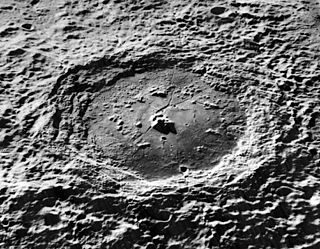 W
WCompton is a prominent lunar impact crater that is located in the northern hemisphere on the far side of the Moon. It lies to the east of the Mare Humboldtianum, and southwest of the walled plain Schwarzschild. To the southeast of Compton is the heavily eroded crater Swann.
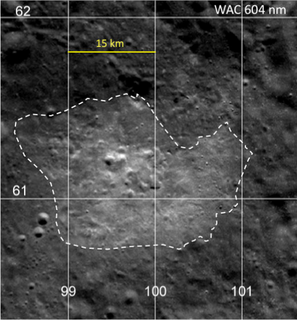 W
WThe Compton–Belkovich Thorium Anomaly is a hotspot on the Moon. It is on the far side of the Moon and was found by a gamma-ray spectrometer in 1998. It is an area of concentrated thorium, a 'fertile' element. Lunar rock samples from the Apollo missions reveal that most lunar volcanism occurred around 3 to 4 billion years ago, but this feature could have formed as recently as 1 billion years ago due to the unknown history of the moon's far side.
 W
WFabry is a large lunar impact crater of the form termed a walled plain. It is located on the far side of the Moon, just beyond the northeastern limb. Parts of this area are sometimes brought into view by the effects of libration, but the terrain is seen from the edge and so not much in the way of detail can be observed.
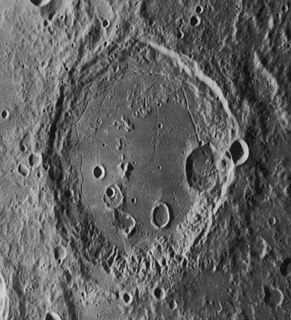 W
WGauss is a large lunar impact crater, named after Carl Friedrich Gauss, that is located near the northeastern limb of the Moon's near side. It belongs to a category of lunar formations called a walled plain, meaning that it has a diameter of at least 110 kilometers, with a somewhat sunken floor and little or no central massif. Due to its location, this crater appears considerably foreshortened when viewed from the Earth, and its visibility is affected by libration.
 W
WGiordano Bruno is a 22-kilometre (14 mi) lunar impact crater on the far side of the Moon, just beyond the northeastern limb. It lies in an area that can be viewed during a favorable libration, although the area is viewed from the side and not much detail can be seen. It lies between the craters Harkhebi to the northwest and Szilard to the southeast.
 W
WHahn is a lunar impact crater that is located near the northeastern limb of the Moon. The crater appears oval when viewed from the Earth due to foreshortening. It is located less than one crater diameter to the southeast of Berosus, a slightly smaller formation.
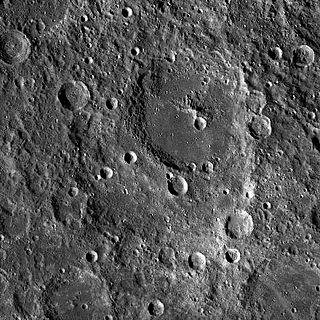 W
WHarkhebi is a large lunar impact crater of the category termed a walled plain, on the far side. Half of the crater to the north-northeast is overlain by the walled plain Fabry, a large formation in its own right. Attached to the northwestern rim is the much smaller crater Vashakidze. To the southwest lies Vestine, and to the south is Richardson.
 W
WHarriot is a lunar impact crater that is located on the far side of the Moon from the Earth. It lies just to the north of the much larger crater Seyfert. To the northeast of Harriot is the crater Cantor. About one and a half crater diameters to the north of Harriot is the eastern end of a crater chain named Catena Sumner. This feature continues to the west-northwest for a distance of 247 km, passing to the north of the crater Sumner.
 W
WHayn is a lunar impact crater that lies next to the northeast limb of the Moon. This location restricts the amount of detail that can be viewed from the Earth, as the western inner side is permanently hidden from sight. Observation of this crater can also be affected by libration, which can completely hide this crater from sight.
 W
WLacus Spei is a small lunar mare that is located in the northeastern part of the Moon's near side. To the north is the crater Mercurius and to the west-southwest lies Schumacher.
 W
WMare Humboldtianum is a lunar mare located just to the east of Mare Frigoris, in the center of Humboldtianum basin. It is located along the northeastern limb of the Moon, and continues on to the far side. Due to its location, the visibility of this feature can be affected by libration, and on occasion it can be hidden from view from Earth.
 W
WMaxwell is a crater on the far side of the Moon named after the physicist James C. Maxwell. It lies in the southwestern part of the larger crater Richardson. The southern part of Maxwell is overlain in turn by the partly flooded Lomonosov. Less than one crater diameter to the southwest is the larger Joliot.
 W
WMercurius is a lunar impact crater that is located in the northeastern part of the Moon. It lies to the northeast of the smaller crater Carrington, and west-northwest of Zeno. Just to the south is the small lunar mare named Lacus Spei, and to the west is the larger Lacus Temporis.
 W
WPetrie is a relatively small lunar impact crater that is located to the east of the much larger walled plain Fabry. To the east is the smaller crater Rayet. Most of the rim of Petrie is sharp-edged, with a deposit of scree along the base of the inner wall. There is an outward bulge to the rim along the southwest, where the surface has slumped into the interior.
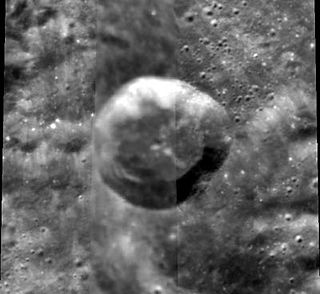 W
WRayet is a small lunar impact crater that lies on the far side of the Moon, past the northeast limb. It lies to the southwest of the larger crater Millikan, and east of the comparably sized Petrie.
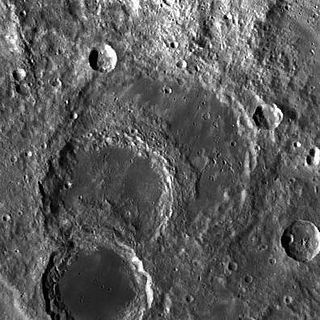 W
WRichardson is a large lunar impact crater located on the Moon's far side, just behind the eastern limb. It lies to the south of the huge walled plain Harkhebi, and to the east-southeast of the crater Vestine. Just to the northeast is Szilard, and to the southeast is Artamonov.
 W
WRiemann is a lunar impact crater that is located near the northeastern limb of the Moon, and can just be observed edge-on when libration effects bring it into sight. It lies to the east-northeast of the large walled plain Gauss. To the southeast, beyond sight on the far side, is the crater Vestine.
 W
WSchumacher is a lunar impact crater that lies in the northeast part of the Moon, just to the north of the larger walled plain Messala. The two formations are separated by a rough strip of terrain less than 10 kilometers across, and bisected by a pair of small, co-joined craters. The northern member of this pair lies across the southern rim of Schumacher, and intrudes into the interior floor.
 W
WSisakyan is a lunar impact crater that is located on the Moon's far side, beyond the northeastern rim. It lies to the east of the huge walled plain Harkhebi, and north of the crater Sumner and the Catena Sumner crater chain.
 W
WSumner is a lunar impact crater on the far side of the Moon, beyond the northeastern limb. It is southwest of the larger crater Szilard, and southeast of the twin walled plains Fabry and Harkhebi.
 W
WSzilard is a damaged lunar impact crater that lies to the east-northeast of the crater Richardson. It is named after Leó Szilárd, the scientist who theorised nuclear chain reactions and famously worked on the atomic bomb during World War II. About a half-crater-diameter to the northwest is the large walled plain Harkhebi. Between Harkhebi and Szilard is the small Giordano Bruno. The ray system from this impact forms streaks across the rim and interior of Szilard.
 W
WVashakidze is a lunar impact crater that is located on the Moon's far side, just beyond the northeastern limb. This area of the surface is not completely hidden from the Earth, however, as suitable combinations of libration and sunlight will bring it into view. The southeastern rim of this crater grazes the outer rim of the huge walled plain Harkhebi. It lies to the southeast of the crater Boss and to the northeast of the ruined walled plain Riemann.
 W
WVestine is a heavily eroded impact crater on the Moon's far side, just beyond the northeastern limb. It lies to the southwest of the large walled plain Harkhebi, and to the northwest of the Maxwell–Richardson crater pair.
 W
WZeno is a lunar impact crater located near the northwestern limb of the Moon. It lies to the east-southeast of the crater Mercurius. Farther to the east of Zeno, along the limb, is the well-formed crater Boss.